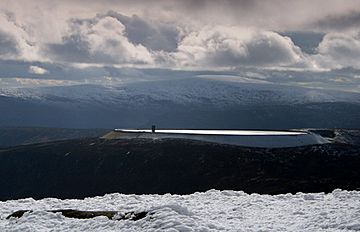Turlough Hill facts for kids
Quick facts for kids Turlough Hill(Cnoc an Turlaigh) |
|
|---|---|
| Tomaneena (Tuaim an Aonaigh) | |

The upper reservoir on Turlough Hill, viewed from Tonelagee
|
|
| Highest point | |
| Elevation | 681 m (2,234 ft) |
| Prominence | 54 m (177 ft) |
| Geography | |
| Location | County Wicklow, Ireland |
| Parent range | Wicklow Mountains |
| OSI/OSNI grid | T063982 |
| Topo map | OSI Discovery No. 56 |
| Climbing | |
| Easiest route | Access road to north of summit |
Turlough Hill (which means "Hill of the Turlach" in Irish) is a mountain in County Wicklow, Ireland. It is also known as Tomaneena, meaning "mound of the assembly/fair". This mountain stands at 681-metre-high (2,234 ft).
Turlough Hill is special because it is home to Ireland's only pumped-storage hydroelectricity plant. This power station is owned and run by the ESB. It can create up to 292 megawatts (392,000 hp) of electricity. This power is used when lots of electricity is needed, like during busy times of the day.
Contents
Discovering Turlough Hill
Turlough Hill is 681 metres (2,234 ft) high. This makes it the 136th tallest mountain in Ireland. The mountain's top is found to the southwest of a large water reservoir. You can easily reach the summit by following a paved road. This road starts at the top of the Wicklow Gap. You can also hike to the top from Glendalough. Other paths come from nearby mountains like Camaderry and Conavalla.
The Mountain's Name
A historian named Liam Price found that local people called the mountain Tomaneena. The name Turlough Hill was given by the ESB. They named it this when they were looking at the site for the power plant. The new name, Turlough Hill, makes sense for the power station. This is because the plant uses water from a lake on top of the mountain. This lake can sometimes become "dry" when the water is used. A "turlough" in Ireland is a low area on limestone. It gets flooded in wet weather when groundwater comes up from the rock.
What the Mountain is Made Of
The ground of Turlough Hill is mostly granite rock. This rock is covered by a thick layer of blanket bog. A blanket bog is a type of wetland that covers large areas. It is home to many interesting plants.
Plants and Wildlife on the Mountain
The blanket bog on Turlough Hill is a habitat for many plants. You can find heather and purple moor grass here. There is also a lot of sphagnum moss. Near the top of the mountain, you can see special alpine plants. These include tiny dwarf willow trees. You might also spot cowberry and crowberry. Other plants found here are fir clubmoss and common bilberry.
Lough Nahanagan: A Glacial Lake
To the northeast of the mountain's top is Lough Nahanagan. Its Irish name, Loch na hOnchon, means "Lake of the Water Monster". This lake is a corrie lake. It was formed by a glacier at the end of the last ice age. A glacier is a huge, slow-moving river of ice. As it moved, it carved out the bowl-shaped area where the lake now sits.
How the Pumped-Storage Plant Works
The Turlough Hill Power Station is run by the Electricity Supply Board (ESB). Building the station started in 1968. It began working fully in 1974.
A pumped-storage plant is like a giant battery. It stores energy using water. Here's how it works:
- When there's extra power: At night, or when electricity demand is low, the plant uses extra power from the national grid. It pumps water from a lower lake up to a higher reservoir on the mountain.
- When power is needed: When people need a lot of electricity, the water from the upper reservoir is released. It flows down through large pipes. This water spins huge turbines, which are like big fans. The spinning turbines then create electricity.
- Quick power: This system can start generating power very quickly. This is helpful when there is a sudden need for more electricity.
Images for kids





